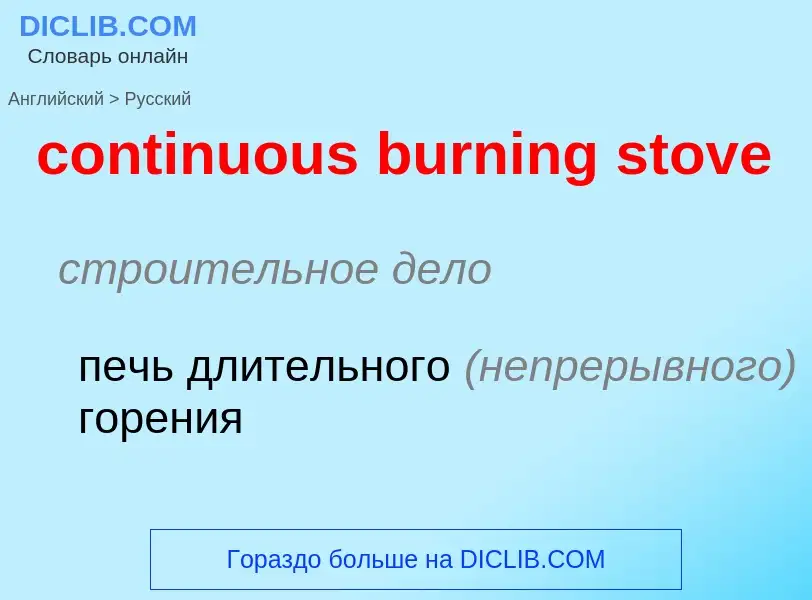Traduzione e analisi delle parole tramite l'intelligenza artificiale ChatGPT
In questa pagina puoi ottenere un'analisi dettagliata di una parola o frase, prodotta utilizzando la migliore tecnologia di intelligenza artificiale fino ad oggi:
- come viene usata la parola
- frequenza di utilizzo
- è usato più spesso nel discorso orale o scritto
- opzioni di traduzione delle parole
- esempi di utilizzo (varie frasi con traduzione)
- etimologia
continuous burning stove - traduzione in russo
строительное дело
печь длительного (непрерывного) горения
[stəuv]
общая лексика
печь
сушительная печь
паровая баня
теплица
оранжерея
воздухонагреватель
печной
строительное дело
печь местного отопления
сушильная печь
сушильная камера
нефтегазовая промышленность
огневой нагреватель
Смотрите также
существительное
[stəuv]
общая лексика
печь
печка
воздухонагреватель
теплица
оранжерея
сушильная камера
грелка для ног
печь, печка
кухонная плита
сушилка
печной
глагол
[stəuv]
общая лексика
сушить (в печке и т. п.)
высаживать в теплице
окуривать серой
past и past participle от stave
Definizione
Wikipedia
Bride burning is a form of domestic violence practiced in countries located on or around the Indian subcontinent. A category of dowry death, bride-burning occurs when a young woman is murdered by her husband or his family for her family's refusal to pay additional dowry. The wife is typically doused with kerosene, gasoline, or other flammable liquid, and set alight, leading to death by fire. Kerosene is often used as the cooking fuel for dangerous small petrol stoves, so it allows the claim that the crime was an accident. It is most common in India and has been a major problem there since at least 1993.
This crime has been treated as culpable homicide and, if proven, is usually punished by up to lifelong imprisonment or death. Bride burning has been recognized as an important problem in India, accounting for around 2,500 deaths per year in the country. In 1995, Time magazine reported that dowry deaths in India increased from around 400 a year in the early 1980s to around 5,800 a year by the middle of the 1990s. A year later, CNN ran a story saying that police receive more than 2,500 reports of bride burning every year. According to Indian National Crime Record Bureau, there were 1,948 convictions and 3,876 acquittals in dowry death cases in 2008.

![A Muslim organization [[Karnataka Forum for Dignity]]'s poster against Dowry system in [[Bangalore, India]] A Muslim organization [[Karnataka Forum for Dignity]]'s poster against Dowry system in [[Bangalore, India]]](https://commons.wikimedia.org/wiki/Special:FilePath/Say no to dowry.jpg?width=200)





.jpg?width=200)
![Palais Rohan]] ([[Strasbourg]], France) Palais Rohan]] ([[Strasbourg]], France)](https://commons.wikimedia.org/wiki/Special:FilePath/Strassburg 5923.jpg?width=200)
![Ethnographic Museum]] ([[Belgrade]], [[Serbia]]) Ethnographic Museum]] ([[Belgrade]], [[Serbia]])](https://commons.wikimedia.org/wiki/Special:FilePath/Stove, Ethnographic Museum, Belgrade.jpg?width=200)
![[[Baroque]] stove in the Neues Schloss Schleißheim (Germany) [[Baroque]] stove in the Neues Schloss Schleißheim (Germany)](https://commons.wikimedia.org/wiki/Special:FilePath/Grosses Kabinett Keramikofen Neues Schloss Schleissheim-1.jpg?width=200)
![Stove tile with personification of America, from Southern Germany, c. 1650–1700, ceramic and polychrome glaze, in the [[Germanisches Nationalmuseum]] ([[Nuremberg]], Germany) Stove tile with personification of America, from Southern Germany, c. 1650–1700, ceramic and polychrome glaze, in the [[Germanisches Nationalmuseum]] ([[Nuremberg]], Germany)](https://commons.wikimedia.org/wiki/Special:FilePath/Stove tile with personification of America, Southern Germany, 1650-1700, ceramic, polychrome glaze - Germanisches Nationalmuseum - Nuremberg, Germany - DSC03737.jpg?width=200)
![Tiled stove (for heating) in the dining room of the [[Catherine Palace]] ([[Saint Petersburg]]) Tiled stove (for heating) in the dining room of the [[Catherine Palace]] ([[Saint Petersburg]])](https://commons.wikimedia.org/wiki/Special:FilePath/Catherine Palace heater.jpg?width=200)
![Schloss Wolfshagen]] ([[Prignitz]], Brandenburg, Germany) Schloss Wolfshagen]] ([[Prignitz]], Brandenburg, Germany)](https://commons.wikimedia.org/wiki/Special:FilePath/Schloss Wolfshagen Gartensaal Ofen.jpg?width=200)
![Neoclassical stove decorated with festoons, in the [[Schloss Senftenberg]] ([[Senftenberg]], Germany) Neoclassical stove decorated with festoons, in the [[Schloss Senftenberg]] ([[Senftenberg]], Germany)](https://commons.wikimedia.org/wiki/Special:FilePath/Ofen Museum Senftenberg.jpg?width=200)
![Neoclassical stove in [[Schloss Rosegg]] ([[Rosegg]], [[Austria]]) Neoclassical stove in [[Schloss Rosegg]] ([[Rosegg]], [[Austria]])](https://commons.wikimedia.org/wiki/Special:FilePath/AT-34724 Schloss Rosegg, Lukretia 045.jpg?width=200)
![Gothic Revival]] stove in the [[Nuremberg Transport Museum]] ([[Nuremberg]], Germany) Gothic Revival]] stove in the [[Nuremberg Transport Museum]] ([[Nuremberg]], Germany)](https://commons.wikimedia.org/wiki/Special:FilePath/DB Museum waiting room heating stove.jpg?width=200)
![Renaissance Revival]] tiled stove in [[Schloss Grafenegg]] (Austria) Renaissance Revival]] tiled stove in [[Schloss Grafenegg]] (Austria)](https://commons.wikimedia.org/wiki/Special:FilePath/Schloss Grafenegg - Kachelofen - 1.jpg?width=200)
![Renaissance Revival tiled stove in the Šustalova vila ([[Kopřivnice]], [[Czech Republic]]) Renaissance Revival tiled stove in the Šustalova vila ([[Kopřivnice]], [[Czech Republic]])](https://commons.wikimedia.org/wiki/Special:FilePath/Kopřivnice, Šustalova vila, expozice (13).jpg?width=200)
![Neo-Rococo]] glazed ceramic stove in [[Lviv]] ([[Ukraine]]) Neo-Rococo]] glazed ceramic stove in [[Lviv]] ([[Ukraine]])](https://commons.wikimedia.org/wiki/Special:FilePath/Камін P1630140 Будинок на вулиці Дорошенка, 19 (Львів).jpg?width=200)
.jpg?width=200)
